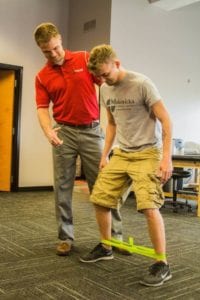Whatever activity it is we’re doing, it’s our feet that have to take and distribute the initial force either during each step, stride, or jump. Although our body is able to use our ankles, knees, and hips to help absorb the pressure, our feet often feel the aches and pains of both overuse activities and acute injuries. These injuries can persist for years or arise from a single movement such as landing from a jump. Whatever the injury may be, our therapists at Makovicka Physical Therapy want to help you get back on track.
The pain you feel can occur at different parts of the foot, including the heel, mid-foot, fore-foot, and toes, and may include injuries like Plantar Fasciitis, Bunion, Ingrown Toenail, Blisters, Heel Spur, Corns, Calluses, Turf Toe, Athletes Foot, Metatarsalgia, and Verrucas.
The ankle joint is made up of three bones that include the tibia, fibula, and talus. There are three main causes of ankle pain, after an injury, which include: strains, sprains, and fractures. An ankle sprain is the most common injury of the three. Sprains and strains happen when a ligament or tendon is stretched farther than normal which can cause inflammation, swelling, and pain.
Common causes of ankle sprains:
- · Sudden changes of direction.
- · Walking or running on uneven surfaces.
- · Playing sports on artificial turf.
- · Improperly fitting footwear.
Ankle strains are more likely to occur if you have previously sprained it as the ligaments become stretched out.
Common Questions and Answers about the Ankle:
Q: What is the difference between an ankle strain and an ankle sprain?
A: An ankle sprain is an injury to the tissue that connects and supports that ankle joint while a strain is an injury to the muscle or tendon attached to a muscle around the ankle.
Q. What are the risk factors of ankle strain/sprain?
- Fatigue – Injury rates commonly go up the more fatigued a person is.
- Environment – Uneven or slippery surfaces can increase chances of injury
- Footwear – Loose or poorly fitting footwear can make you more prone to ankle injuries.
Q. What is the treatment for these injuries? Is it the same treatment for both injuries?
A. If you have sprained/strained your ankle in the last 24-48 hours follow the R.I.C.E. protocol.
Q. What is the R.I.C.E. protocol?
- Rest: Give yourself time to heal by keeping weight off your ankle. Crutches may help you get around if the pain doesn’t go away.
- Ice: Make sure to ice right after the injury to decrease the pain and swelling. Ice 15-20 minutes every couple hours for the first few days or until pain and swelling has decreased.
- Compression: By using an elastic bandage, you can decrease the swelling. Make sure to start wrapping the bandage at your toes and work your way towards your leg. Loosen
- Elevation: Prop your ankle up using a pillow or bolster. Especially at night, to allow gravity to help reduce swelling.
Q. Is heat ever recommended for treatment?
A. Heat is recommended for injuries that are “chronic” or lasting longer than a couple weeks. Ice is commonly recommended for “acute” injuries that have occurred over the last 48 hours.
Q. Is there a way to prevent these injuries?
A. The best prevention for ankle injuries is to use regular strengthening and stretching. The stronger the muscles around a joint, the more they will be able to “brace” or support that joint.
Q. What is an ankle fracture? What is the treatment?
A. An ankle fracture occurs when one or more of the bones of the ankle break, usually after an injury. Common treatment for an ankle fracture is to cast or splint the area and reduce weight-bearing for up to 4-8 weeks.
Q. Diagnosis of your ankle injury.
A. Your doctor or physical therapist will perform a physical exam that will help to determine the extent and severity of the injury. Imaging can be ordered by your doctor and may include X-rays to find any fractures that may have occurred or an MRI to determine ligament or tendon damage.
Q. When can I return to sport?
A. Safe return to sport after an ankle injury depends on the severity of the injury. Your physical therapist will assess you every visit and progress you towards return to sport based on pain reproduction, swelling, ankle strength, and range of motion.
Q. What is a good source for learning more?
A. Your best source of information will come from scheduling a visit with your primary care physician or physical therapist as they will be able to assess your injury and treat it or will know where you need to go to get the proper treatment.
Ryan Thayer PT, DPT

